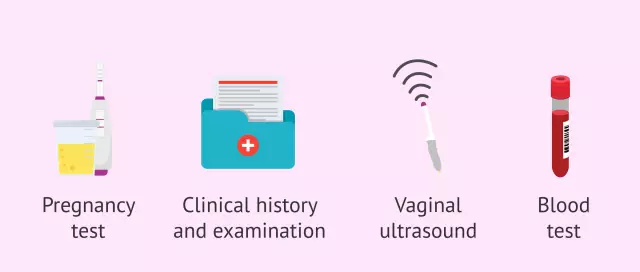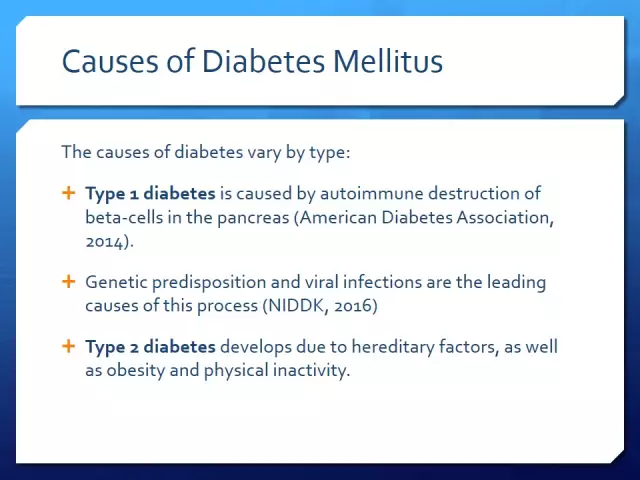- Author Rachel Wainwright [email protected].
- Public 2023-12-15 07:39.
- Last modified 2025-11-02 20:14.
Diabetes insipidus
General characteristics of the disease

Diabetes insipidus is a syndrome caused by a deficiency in the body of vasopressin. This substance is also called antidiuretic hormone. It is formed in the hypothalamus, accumulates in the pituitary gland and is responsible for the balance of fluids in the body: blood, water, extracellular fluid, etc.
Diabetes insipidus develops as a result of pituitary pathologies provoked by benign or malignant metastatic tumors. Another possible cause of destructive processes in the pituitary gland is unsuccessful surgical interventions on the brain. Approximately every 5th case of diabetes insipidus is an example of such an unsuccessful neurosurgical operation.
Diabetes insipidus is not a hereditary disease. However, in a number of autosomal recessive inherited syndromes, for example, in Wolfram's disease, complete or incomplete diabetes insipidus is part of the clinical picture of a genetic mutation.
Diabetes insipidus is a rather rare disease. It leaves no more than 0.7% of all endocrine pathologies. Diabetes insipidus is equally often diagnosed in women and men. In children, diabetes insipidus is usually congenital, although its diagnosis can occur quite late - after 20 years. In adults, the acquired form of the disease is more often diagnosed.
Types of diabetes insipidus
In addition to congenital diabetes insipidus in children and acquired form in adults, the disease can also be central, renal, or idiopathic.
Central diabetes insipidus
Central or hypothalamic-pituitary diabetes insipidus develops as a result of the kidney's inability to store fluid. This pathology is caused by disturbances in the work of the distal tubules of the nephron. As a result, a patient with central diabetes insipidus suffers from frequent urination and polydipsia, a syndrome of unquenchable thirst.
If the patient has the opportunity to drink unlimited amounts of liquid, he is practically not in danger. If it is impossible to quench his thirst in time, a patient with diabetes insipidus of this form develops severe dehydration (hyperosmolar dehydration). The extreme stage of this syndrome is hyperosmolar coma, which is life-threatening.
With long-term central diabetes insipidus, the patient develops renal insensitivity to the artificially administered antidiuretic hormone. Therefore, the earlier the treatment of diabetes insipidus of this form is started, the more favorable the prognosis.
In addition, large amounts of fluid consumed in diabetes insipidus can lead to biliary dyskinesia, gastric emptying, or the development of irritable bowel syndrome.
Idiopathic diabetes insipidus
A third of cases of the disease are idiopathic diabetes insipidus. This means that during the diagnosis of diabetes insipidus during imaging of the pituitary gland, it is not possible to reveal any organic pathologies of the organ.
Renal diabetes insipidus

The disease is caused by a receptor, enzymatic defect or organic kidney disease. This is a rather rare form of diabetes insipidus in children, usually congenital. It is provoked by mutations in the aquaporin-2 gene or the vasopressin receptor.
Acquired renal diabetes insipidus in adults develops as a result of renal failure of various etiologies, prolonged therapy with lithium preparations, hypercalcemia, etc.
Diabetes insipidus symptoms
The main symptoms of diabetes insipidus are urinary frequency (polyuria) and thirst syndrome (polydipsia). The severity of these symptoms of diabetes insipidus can be of varying intensity.
With an incomplete deficiency of antidiuretic hormone, only a slight manifestation of symptoms of diabetes insipidus is possible. The idiopathic form, on the contrary, is characterized by an acute onset of the disease.
The clinical symptoms of long-term diabetes insipidus are:
- an increase in the size of the bladder,
- stretching and drooping of the stomach,
- hypotension (low blood pressure),
- signs of dehydration.
Symptoms of diabetes insipidus in children can be especially acute, up to the development of neurological disorders, a sharp rise in temperature, debilitating vomiting, urinary incontinence and hyperosmolar coma.
Diagnosis of diabetes insipidus
In the diagnosis of diabetes insipidus, a polyuria test is used. Normally, the amount of urine excreted should not exceed 3 liters per day. The urine of a patient with diabetes insipidus is characterized by an excess of these indicators, as well as a low urine density.
The second test used to diagnose diabetes insipidus is called the dry food test. The patient is advised to refrain from drinking for 8 hours. If during this period of time the patient has a sharp decrease in body weight, and the urine density does not exceed 300 mosm / l, the patient is diagnosed with diabetes insipidus.
Differential diagnosis of diabetes insipidus assumes the exclusion of insulin-dependent diabetes, organic pathologies of the kidneys, mental and neurotic disorders, the presence of tumors in the hypothalamic-pituitary region.
Diabetes insipidus treatment
The treatment of diabetes insipidus is based on replacement therapy with synthetic analogues of vasopressin. Drugs that can compensate for the level of antidiuretic hormone in the body include Desmopressin or Adiuretin. They come in the form of tablets or nasal sprays.
In the treatment of diabetes insipidus with desmopressin tablets, dosages of up to 0.4 mg 3-4 times a day are used. Nasal injection of liquid with synthetic vasopressin should also be carried out at least 3 times a day.

In the treatment of diabetes insipidus, drugs with a longer effect are also used, for example, Pitressin Tanat. It can be used once every 3-5 days.
Diet therapy plays an important role in the treatment of diabetes insipidus. All patients with a deficiency of antidiuretic hormone in the body are recommended to eat fractionally and increase the amount of complex carbohydrates in the diet (potatoes, vegetables, cereals, legumes, meat, nuts).
Stimulation of the production of natural vasopressin in incomplete diabetes insipidus is carried out with the drugs Chlorpropamide and Carbomazepine.
Patients with a pituitary tumor are shown surgical treatment of diabetes insipidus - removal of the tumor and, if necessary, radiation.
YouTube video related to the article:
The information is generalized and provided for informational purposes only. At the first sign of illness, see your doctor. Self-medication is hazardous to health!






